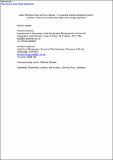Files in this item
Late-Holocene land surface change in a coupled social-ecological system, southern Iceland : a cross-scale tephrochronology approach
Item metadata
| dc.contributor.author | Streeter, Richard Thomas | |
| dc.contributor.author | Dugmore, Andrew | |
| dc.date.accessioned | 2017-05-05T16:30:08Z | |
| dc.date.available | 2017-05-05T16:30:08Z | |
| dc.date.issued | 2014-02-15 | |
| dc.identifier | 91401282 | |
| dc.identifier | 5c35a037-c7a4-4d17-8a69-57f85b2ec885 | |
| dc.identifier | 84892838664 | |
| dc.identifier | 000331991100009 | |
| dc.identifier.citation | Streeter , R T & Dugmore , A 2014 , ' Late-Holocene land surface change in a coupled social-ecological system, southern Iceland : a cross-scale tephrochronology approach ' , Quaternary Science Reviews , vol. 86 , pp. 99-114 . https://doi.org/10.1016/j.quascirev.2013.12.016 | en |
| dc.identifier.issn | 0277-3791 | |
| dc.identifier.other | ORCID: /0000-0003-2261-4540/work/64697930 | |
| dc.identifier.uri | https://hdl.handle.net/10023/10712 | |
| dc.description | This work is supported by a UK Natural Environment Research Council (NERC) PhD studentship (NE/F00799X/1) | en |
| dc.description.abstract | The chronological challenge of cross-scale analysis within coupled socio-ecological systems can be met with tephrochronology based on numerous well-dated tephra layers. We illustrate this with an enhanced chronology from Skaftártunga, south Iceland that is based on 200 stratigraphic profiles and 2635 individual tephra deposits from 23 different eruptions within the last 1140 years. We present new sediment-accumulation rate based dating of tephra layers from Grímsvötn in AD 1432 ± 5 and AD 1457 ± 5. These and other tephras underpin an analysis of land surface stability across multiple scales. The aggregate regional sediment accumulation records suggest a relatively slow rate of land surface change which can be explained by climate and land use change over the period of human occupation of the island (after AD ∼870), but the spatial patterning of change shows that it is more complex, with landscape scale hysteresis and path dependency making the relationship between climate and land surface instability contingent. An alternative steady state of much higher rates of sediment accumulation is seen in areas below 300 m asl after AD ∼870 despite large variations in climate, with two phases of increased erosion, one related to vegetation change (AD 870–1206) and another related to climate (AD 1597–1918). In areas above 300 m asl there is a short lived increase in erosion and related deposition after settlement (AD ∼870–935) and then relatively little additional change to present. Spatial correlation between rates of sediment accumulation at different profiles decreases rapidly after AD ∼935 from ∼4 km to less than 250 m as the landscape becomes more heterogeneous. These new insights are only possible using high-resolution tephrochronology applied spatially across a landscape, an approach that can be applied to the large areas of the Earth's surface affected by the repeated fallout of cm-scale tephra layers. | |
| dc.format.extent | 15 | |
| dc.format.extent | 4315600 | |
| dc.language.iso | eng | |
| dc.relation.ispartof | Quaternary Science Reviews | en |
| dc.rights | Copyright © 2014 Elsevier Ltd. All rights reserved. This work has been made available online in accordance with the publisher’s policies. This is the author created accepted version manuscript following peer review and as such may differ slightly from the final published version. The final published version of this work is available at: https://doi.org/10.1016/j.quascirev.2013.12.016 | en |
| dc.subject | Grímsvötn | en |
| dc.subject | Iceland | en |
| dc.subject | Soil erosion | en |
| dc.subject | Little Ice Age | en |
| dc.subject | Resilience | en |
| dc.subject | QE Geology | en |
| dc.subject | GE Environmental Sciences | en |
| dc.subject | BDC | en |
| dc.subject | SDG 13 - Climate Action | en |
| dc.subject | SDG 15 - Life on Land | en |
| dc.subject.lcc | QE | en |
| dc.subject.lcc | GE | en |
| dc.title | Late-Holocene land surface change in a coupled social-ecological system, southern Iceland : a cross-scale tephrochronology approach | en |
| dc.type | Journal article | en |
| dc.contributor.institution | University of St Andrews.Geography & Sustainable Development | en |
| dc.contributor.institution | University of St Andrews.Bell-Edwards Geographic Data Institute | en |
| dc.identifier.doi | 10.1016/j.quascirev.2013.12.016 | |
| dc.description.status | Peer reviewed | en |
| dc.identifier.url | http://www.sciencedirect.com/science/article/pii/S0277379113004976#appd001 | en |
This item appears in the following Collection(s)
Items in the St Andrews Research Repository are protected by copyright, with all rights reserved, unless otherwise indicated.

